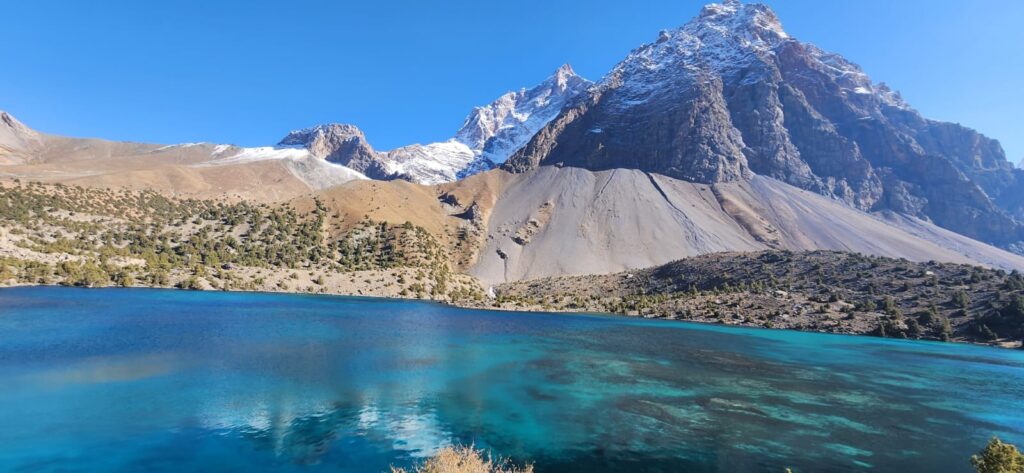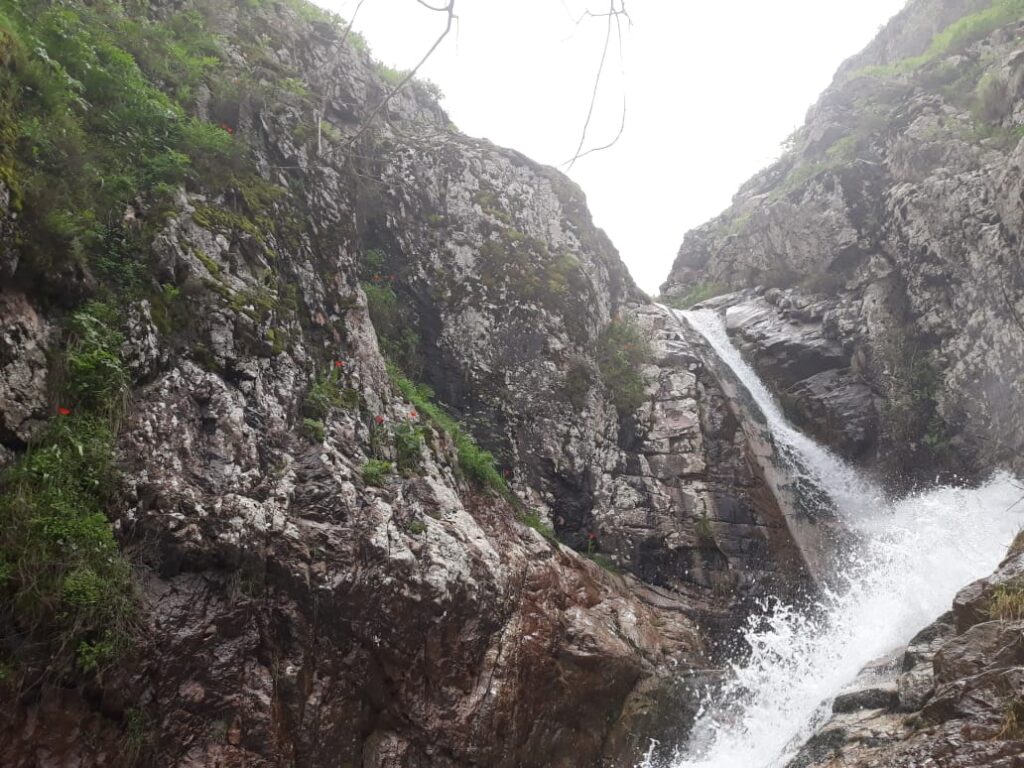In valleys of southern Tajikistan, slopes once draped in pistachio and almond trees whisper of a vanished abundance. Now, the forests appear thinner, patchy, edged by bare rock and scrub. To walk these slopes is to walk memory and erosion together. The pistachio forest is not simply ecological, it is a cultural landscape, a human-shaped terrain where people and trees coexisted. Its decline is geography written by choices, climate, and neglect.
Pistachio woodlands (essentially Pistacia vera and wild relatives) once flourished in foothill zones, between roughly 1,200–2,000 meters elevation, often on south-facing slopes with shallow soils. In spring, their leaves flicker bright green; in Autumn, wild pistachio crops which are small, nutty, oily are collected, often by families climbing steep slopes. They supply food, firewood, fodder, even medicine. In many villages, harvesting pistachios is part of seasonal rhythm: children climb, neighbors gather, nuts are shelled and stored.
But that rhythm weakens. In many places the forest is thinning. Saplings are grazed before they establish. Overharvesting of branches for fuel prevents regrowth. Drought years stress surviving trees; soils erode; slopes fail. In one slopeside orchard near Vakhsh, only a few large trees remain; the understory is bare. A local villager says, “My grandfather sold nuts to Bukhara caravans. Now the trees are too few to pick.”
The geography of decline is patchy, while some slopes hold, others collapse. Soil depth matters. Where soils over rock remain shallow, pistachios struggle and slower regrowth follows. Where cracks in bedrock allow moisture accumulation, trees hold on. Often, patches near springs or seep lines have better survival, reflecting the micro-topography’s role in shaping persistence.
Pistachio forests are slow geographies- they are trees that grow over decades, hold soil, anchor microclimates, and become interwoven with humanity’s presence. Their disappearance is not sudden, but incremental: fewer saplings, thinning crowns, gaps expanding. One slope that is still green today may be bare tomorrow. It is a loss measured in years and memory, not headlines.
Historical maps from Russian and Soviet times show continuous pistachio-wooded slopes in many southwestern districts. Soviet forestry reports of the mid-20th century mapped pistachio belts extending across certain ridgelines, often protected or managed. These maps help anchor today’s comparison. When we overlay current satellite imagery with those older maps, the contraction is visible: many groves shrank or fragmented. One study (Nobis et al., 2011) in the Hissar and Zeravshan ranges found that pistachio woodland area dropped by over 30% in some districts over half a century.
The forests are also boundary markers of cultural landscapes. Houses built with local pistachio wood, hedges shaped with its sprays, fences made from dead limbs: these landscapes carry tree memory. In villages, pistachios frame courtyards, their nuts part of weddings, their sap used in folk medicine. Their decline is not just ecological but symbolic: a rupture in local identity.
Climate amplifies stresses. Drought intensity increases; rainfall becomes erratic. Pistachios are drought-tolerant, but only within bounds. A bad drought lasting two or three seasons can weaken trees, reduce flowering, reduce seed set. In extreme years, mortality edges up. Coupled with soil erosion, the land loses its ability to support these woodlands. In a projected climate model for Central Asia, increased variance in precipitation plus increased evapotranspiration pose a threat to marginal semi-arid forests (UNEP, 2012).
Human pressures compound the decline. Fuelwood demand is acute. Many rural homes lack reliable electricity or gas, forcing families to turn to shrubs and tree branches for cooking and heating. Pistachio trees are among the easiest to reach on slopes, so they are harvested heavily. Grazing is another factor: goats browse young shoots, preventing regeneration. In a survey in Khatlon, villagers cited grazing as a major barrier to regeneration, noting that fenced plots or tree guards were rare. Institutional support is limited.
Some replanting experiments exist. NGOs in certain districts try to cultivate pistachio saplings in nurseries, then plant them uphill from villages and protect them with wire fencing. But success is mixed; many saplings fail in first summers. Without watering, protection, and maintenance, they die. One NGO manager in 2015 confesses: “We planted thousands; only a few hundred survive.” The cost, logistics, and harsh terrain conspire against success.
Another intervention is selective thinning of competing species, reducing pressure on pistachios. In mixed slopes, removal of shrubs that draw water or shade pistachio seedlings helps. Mulching, contour bunds, and water harvesting from runoff channels also give support. In a few villages, households collect rock debris to build micro-retention walls upslope, retaining water and reducing runoff. Over time, these small measures may help fragility zones persist.
Mapping these change patterns is essential. A combination of satellite remote sensing, aerial photos, and ground truthing can estimate forest cover, fragmentation, and regeneration. Researchers use Normalized Difference Vegetation Index (NDVI) to detect greenness trends. In Tajikistan, moderate resolution imagery (such as Landsat) allows tracking pistachio woodland patches over decades. But distinguishing pistachio from other shrubs is challenging; field surveys remain necessary. Mapping, then, becomes community work: villagers marking surviving plots, volunteers GPSing groves, cross-referencing older maps.
The spatial dynamics are telling. Remnant groves often occur in steep, rocky slopes that deter livestock and firewood harvest or in gullies where moisture concentrates. Forest patches near roads or villages tend to shrink fastest. In one mapped zone near Panj, forest fragments within 500 meters of roads lose canopy cover faster than those deeper in slopes. The edge effect is real: trees at forest edges suffer microclimate stress, wind, and harvest pressure more than interior trees.
The decline of pistachio forests has knock-on consequences. Loss of tree cover accelerates erosion: without root structure, slopes lose cohesion. Soil washes away more easily, gullies deepen, and topsoil depletes. This depletes agricultural potential. Water retention declines. Biodiversity suffers: birds, insects, small mammals lose habitat. The forest’s buffering of microclimate- shade, wind breaks is vanishing, therefore exposing croplands to harsher sun and wind.
Walking one slope, you see it: earth color shifts from chestnut to pale dust. Stones cover ground. Young pistachio seedlings are sparse and stressed. A gust of wind lifts dust. The slope feels brittle. Farther downhill, a narrow band of surviving trees shades a spring. That spring supports a small patch of field. It is a remnant, anchored by trees and water working together.
Protecting these forests demands both patience and integration. Policies must reduce fuelwood pressure by adopting affordable alternative energy, more efficient stoves. Livestock management must include exclusion zones. Fencing, tree guards, community forests must be supported. Economic value must shift: pistachio nut commerce, agroforestry with nut harvests, ecosystem payments. If communities gain economic benefit from standing forests, preservation becomes rational.
In the kitchen of a small home, a grandmother shells pistachios, telling grandchildren of how there used to be “green walls” along hills. Her stories tie food, land, and identity. Even in decline, the pistachio forest lives in memory. Mapping its decline is not just science, it is a mapping of loss, of heritage, of geography tied to people.
As dusk falls, wind softens. The last light glows across knolls. The hillsides look skeletal where once they were cloaked. But in sheltered nooks, a few pistachio crowns hold green. They wait. Their survival signals hope: that landscapes that seem lost can, with care, reassemble. The forest in decline is not finished; it is breathing, waiting, fragile. To walk that slope is to feel both absence and possibility, soil and roots, memory and future.
References
- Nobis, M., Nowak, A., & Nobis, A. (2011). Decline of pistachio woodlands in Central Asia: A case study from Tajikistan. Journal of Forest Research, 16(5), 429–439.
- UNEP. (2012). Global Environment Outlook: Central Asia Chapter. Nairobi: United Nations Environment Programme.
- FAO & Tajik Forestry Reports. (2005). Forest Cover of Tajikistan.








